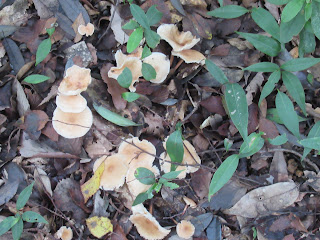So far, many predictions about 2020 have failed to materialize. In September, Japan Meteorological Agency said we would have a warm October. At least in Kanagawa Prefecture, that forecast has, it seems to me, widely missed the target. Beautiful sunshine was hard to come by. North wind was blowing … COVID or not, we were happy to come home early and be cozy in blanket watching tele. An important ingredient here is hot drink. These days I enjoy herbal teas for evening. They are warm and do not contain, if any, much caffein. A cup of tisane can help me sleep well and maintain enough level of immunity for my body. Damned COVID-19! This September, I collected 3 kinds of leaves from forests to make home-made herbal tea which I enjoy now. This week, I show you how to make tisane from Kuma bamboo grass leaves, one of the 3 plants I use for my tea.
<Tea
with Kuma bamboo grass (Sasa veitchii)>
Kuma bamboo grass has the largest leaves among sasa bamboos in Japan. So, they are often used for cooking (; in my post on May 22, 2020). Normally, they are for wrapping foods, or as mats on dishes to serve meals. Some Japanese local knowledge says they have medicinal values (like here) if taken in powder. Not enough scientific evidence is there to prove this, at least as of October 2020. One thing for sure is, it is not poisonous, and has been used as an ingredient for Japanese traditional herbal medicine for millennium. Before, tea was expensive drink exclusive for rich and powerful. Ordinary people may have used ubiquitous Kuma bamboo grass for a hot cup ‘tea.’ OK. Let’s try it. The way to make Kuma bamboo grass tea is soooooooooo simple:
1. Harvest fully-opened leaves of Kuma bamboo grass, which means people can collect the ingredient almost all year round in anywhere Japan.
2. Wash the leaves well by running water, and cut them in strips.
Er, there is no special thing to do. I tried Kuma bamboo grass tea by making a cocktail with ordinary green tea. (Admitting, this makes my cup with caffeine.) The ratio which is easy to drink is, at least for me, 1 portion of bamboo leaves and 4 tsp of green leaves. Even with this amount, Kuma bamboo makes the flavor of green tea very robust, without making the cup bitter. Please try if you find large bamboo grass while you’re strolling in your neighborhood. They are simply so ubiquitous in Japan.
If you find environmental issues in Kanagawa Prefecture, please make a contact with Kanagawa Natural Environment Conservation Center 神奈川県自然環境保全センター
657 Nanasawa, Atsugi City, 243-0121
〒243-0121 厚木市七沢657
Phone: 046-248-0323
You can send an enquiry to them by clicking the bottom line of their homepage at http://www.pref.kanagawa.jp/div/1644/






No comments:
Post a Comment